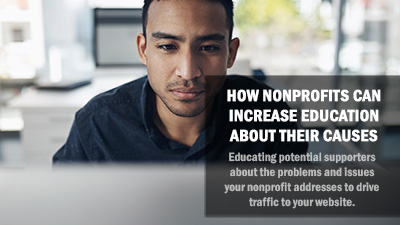 In the world of nonprofits, raising awareness and educating the public about the causes you champion is vital. Effective education not only informs but also inspires action and support. One of the most powerful tools at your disposal is your website. By driving traffic to your website, you can significantly boost your educational outreach. Here, we delve into the top strategies for increasing education about the problems and issues your nonprofit addresses.
In the world of nonprofits, raising awareness and educating the public about the causes you champion is vital. Effective education not only informs but also inspires action and support. One of the most powerful tools at your disposal is your website. By driving traffic to your website, you can significantly boost your educational outreach. Here, we delve into the top strategies for increasing education about the problems and issues your nonprofit addresses.
1.1 Web Pages
Creating an easy-to-understand and engaging collection of web pages can offer visitors a point-and-click environment that helps them learn more about the issues and problems your nonprofit addresses.
Key Strategies:
1.2 Blog Posts
Creating and maintaining a blog on your nonprofit's website is one of the most effective ways to educate your audience. Regularly published blog posts can cover a variety of topics related to your cause, providing readers with in-depth insights and up-to-date information.
Key Strategies:
1.3 Educational Resources
Offering downloadable educational resources can enhance your credibility and provide your audience with valuable information that they can refer to and share.
Key Strategies:
2.1 Keyword Research
SEO is critical in ensuring that your content reaches the right audience. Keyword research helps you identify the terms and phrases that potential visitors are searching for related to your cause.
Key Strategies:
2.2 On-Page SEO
Optimizing your website's pages can improve your search engine rankings, making it easier for people to find your content.
Key Strategies:
3.1 Awareness Campaigns
Social media platforms are invaluable for spreading awareness and driving traffic to your website. Running targeted campaigns can help you reach a broader audience.
Key Strategies:
3.2 Video Content
Video content is highly engaging and can effectively communicate complex issues in an accessible format.
Key Strategies:
4.1 Guest Blogging
Collaborating with other websites and blogs can introduce your nonprofit to new audiences and drive traffic back to your site.
Key Strategies:
4.2 Influencer Partnerships
Partnering with influencers who are passionate about your cause can help you reach a larger audience.
Key Strategies:
Educating the public about the problems and issues your nonprofit addresses is essential for building awareness and support. By leveraging content marketing, SEO, social media campaigns, and partnerships, you can drive targeted and engaged traffic to your website. These strategies not only enhance your online presence but also amplify your impact, helping you achieve your mission more effectively.
Implementing these tactics will ensure that your nonprofit’s website becomes a central hub for education, engagement, and action, ultimately driving positive change for the causes you champion.
Bonus Action Point: Take 10 minutes to write down as many aspects of the problem or issue your nonprofit addresses as you can think of. Break bigger problems/issues into as many smaller bullet points as possible. This will be the basis for the expansion of the information on your website.
As a nonprofit organization, driving traffic to your website is crucial for increasing awareness, engagement, and support for your cause. A well-strategized approach to providing compelling information about the prescriptions you offer can significantly enhance your online presence.
If your nonprofit's website isn't contributing to your most important key metrics, there is a simple process you can go through to improve it. Using goals (not best practices), you can increase the reach, connections, and contributions your website drives month after month.
We hear about it all the time. Because resources are low and what a website truly means for their organizations isn’t clear, nonprofit leaders use volunteer staff, teenagers in high school, or a donor’s resources to help them establish their web presence. It seems like a good deal - the volunteer meets the needs of the nonprofit and the nonprofit avoids investing money and time into a website. But, when you explore the problems associated with doing this, you uncover the true cost of using volunteers to create your worldwide presence.